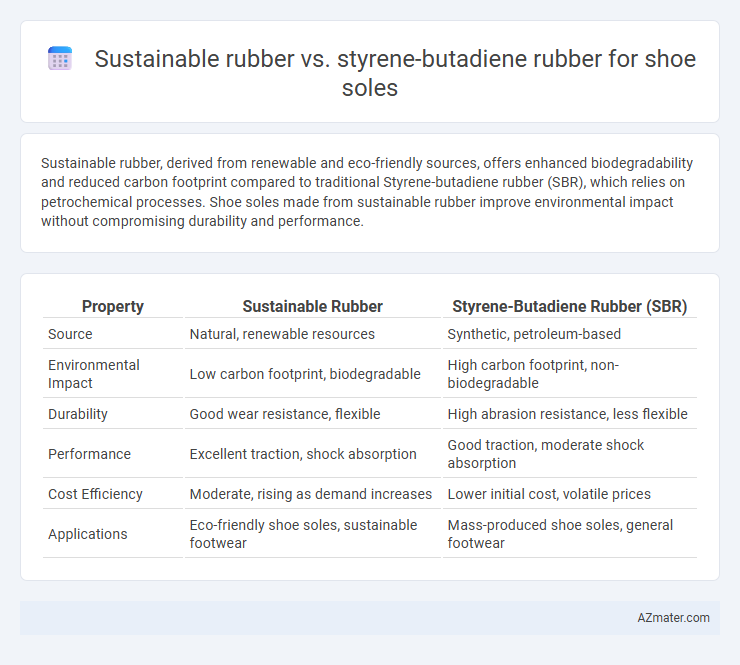Sustainable rubber, derived from renewable and eco-friendly sources, offers enhanced biodegradability and reduced carbon footprint compared to traditional Styrene-butadiene rubber (SBR), which relies on petrochemical processes. Shoe soles made from sustainable rubber improve environmental impact without compromising durability and performance.
Table of Comparison
| Property | Sustainable Rubber | Styrene-Butadiene Rubber (SBR) |
|---|---|---|
| Source | Natural, renewable resources | Synthetic, petroleum-based |
| Environmental Impact | Low carbon footprint, biodegradable | High carbon footprint, non-biodegradable |
| Durability | Good wear resistance, flexible | High abrasion resistance, less flexible |
| Performance | Excellent traction, shock absorption | Good traction, moderate shock absorption |
| Cost Efficiency | Moderate, rising as demand increases | Lower initial cost, volatile prices |
| Applications | Eco-friendly shoe soles, sustainable footwear | Mass-produced shoe soles, general footwear |
Introduction to Shoe Sole Materials
Shoe sole materials play a crucial role in determining durability, comfort, and environmental impact of footwear. Sustainable rubber, derived from natural sources or recycled materials, offers enhanced biodegradability and reduces carbon footprint compared to traditional Styrene-butadiene rubber (SBR), a synthetic polymer known for its abrasion resistance and cost-effectiveness. Choosing between sustainable rubber and SBR affects performance metrics such as elasticity, wear resistance, and eco-friendliness, making material selection critical for sustainable footwear innovation.
What is Sustainable Rubber?
Sustainable rubber is derived from natural rubber trees managed through eco-friendly agricultural practices designed to minimize environmental impact, promote biodiversity, and ensure fair labor conditions. It contrasts with Styrene-butadiene rubber (SBR), a synthetic polymer made from petrochemicals, which typically has a higher carbon footprint and limited biodegradability. Utilizing sustainable rubber in shoe soles supports reduced greenhouse gas emissions and enhances the overall lifecycle sustainability of footwear products.
Overview of Styrene-Butadiene Rubber (SBR)
Styrene-Butadiene Rubber (SBR) is a synthetic elastomer widely used in shoe soles due to its excellent abrasion resistance, durability, and cost-effectiveness. Its copolymer composition, combining styrene and butadiene, provides a balance of toughness and flexibility, making it ideal for high-performance footwear applications. However, SBR's reliance on petroleum-based raw materials highlights the environmental advantages of sustainable rubber alternatives in reducing carbon footprint and enhancing biodegradability for eco-friendly shoe production.
Environmental Impact Comparison
Sustainable rubber, often sourced from natural latex or renewable bio-based materials, significantly reduces carbon emissions and biodegrades more efficiently compared to styrene-butadiene rubber (SBR), a synthetic polymer derived from petroleum. The production of sustainable rubber involves lower energy consumption and minimizes toxic chemical use, resulting in less environmental pollution and reduced landfill waste. In contrast, SBR soles contribute to microplastic pollution and present challenges in recycling, increasing their long-term ecological footprint.
Durability and Performance: Sustainable Rubber vs SBR
Sustainable rubber compounds enhance shoe sole durability by offering superior abrasion resistance and elasticity compared to conventional Styrene-butadiene rubber (SBR), reducing wear and tear under dynamic conditions. Performance metrics such as tensile strength and resilience in sustainable rubbers often exceed those of SBR, leading to improved shock absorption and longer lifecycle in footwear applications. The eco-friendly sourcing of sustainable rubber does not compromise its mechanical properties, making it a viable alternative for high-performance, durable shoe soles.
Comfort and Flexibility Factors
Sustainable rubber, derived from natural latex and eco-friendly processing methods, offers superior breathability and resilience, enhancing comfort in shoe soles by reducing foot fatigue and improving moisture management. Styrene-butadiene rubber (SBR) provides excellent abrasion resistance and durability but tends to be stiffer, which can limit flexibility and reduce overall comfort during prolonged wear. The elasticity of sustainable rubber allows for better adaptability to foot movements, resulting in enhanced flexibility and a more natural walking experience compared to SBR-based soles.
Cost Analysis and Market Availability
Sustainable rubber, often derived from natural sources like guayule or recycled materials, typically incurs higher initial costs compared to Styrene-butadiene rubber (SBR) due to limited large-scale production and processing complexities. Styrene-butadiene rubber, a synthetic polymer widely used in shoe soles, benefits from established manufacturing infrastructure and lower raw material prices, resulting in more cost-effective and readily available supply chains. Market availability favors SBR with its global production dominance, whereas sustainable rubber remains niche but is gaining traction as demand for eco-friendly alternatives rises in the footwear industry.
Biodegradability and End-of-Life Disposal
Sustainable rubber, derived from natural sources like guayule or Hevea brasiliensis, exhibits superior biodegradability compared to synthetic Styrene-butadiene rubber (SBR), breaking down more efficiently under environmental conditions. End-of-life disposal of sustainable rubber results in lower environmental impact due to its ability to decompose into non-toxic organic compounds, whereas SBR often persists in landfills, contributing to microplastic pollution. Advanced recycling technologies for SBR remain limited, making sustainable rubber a more eco-friendly choice for shoe sole manufacturing with reduced ecological footprint.
Consumer Preferences and Trends
Sustainable rubber, derived from natural sources like Hevea brasiliensis, is increasingly favored by eco-conscious consumers seeking biodegradable and renewable materials in shoe soles. Styrene-butadiene rubber (SBR), known for its durability and cost-effectiveness, remains popular in mass-market footwear but faces criticism due to its petroleum-based origin and environmental impact. Current trends indicate a growing consumer shift towards sustainable rubber in premium and performance shoe soles, driven by rising awareness of environmental sustainability and demand for green products.
Future Prospects in Shoe Sole Innovation
Sustainable rubber, derived from renewable sources such as guayule or dandelion, offers promising future prospects in shoe sole innovation by reducing environmental impact and enhancing biodegradability compared to Styrene-butadiene rubber (SBR), a petroleum-based synthetic commonly used for durability and abrasion resistance. Advances in bio-based polymer blends and green processing methods are driving research towards improving the mechanical properties of sustainable rubber to match or exceed those of SBR, making it viable for high-performance footwear applications. Industry trends indicate increasing consumer demand for eco-friendly materials, motivating manufacturers to invest in sustainable rubber technologies that support circular economy principles without compromising the functional integrity of shoe soles.

Infographic: Sustainable rubber vs Styrene-butadiene rubber for Shoe sole
 azmater.com
azmater.com